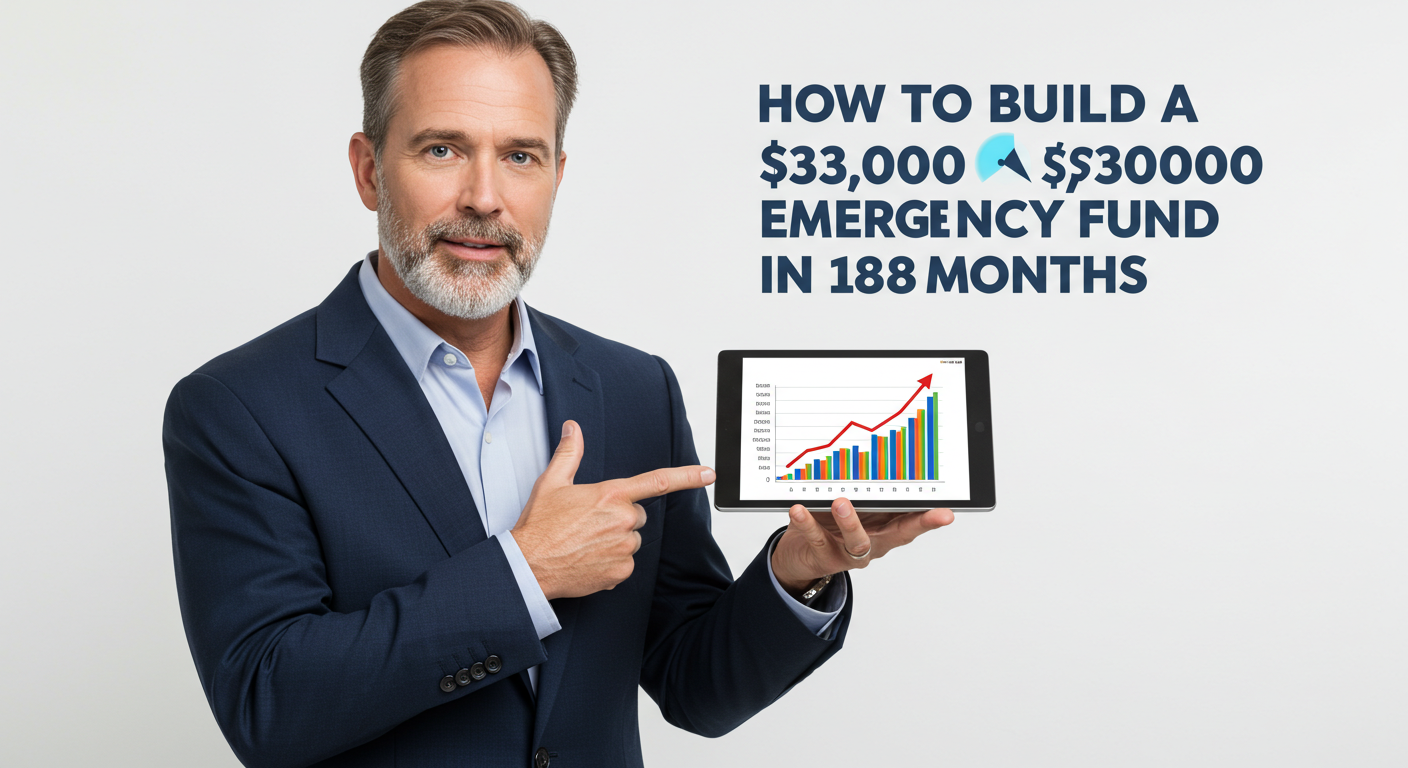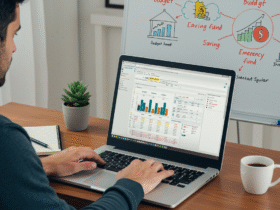Picture this: You’re sitting at your kitchen table, coffee in hand, scrolling through your banking app when suddenly your washing machine decides to throw in the towel. Literally. Water everywhere, repair quote that makes your eyes water more than the flood in your laundry, and you’re left wondering – how do people actually handle these curveballs without losing their minds?
Well, mate, that’s where an emergency fund comes in. Think of it as your financial umbrella for life’s unexpected storms.
What Exactly Is This Emergency Fund Everyone Bangs On About?
An emergency fund is simply money you’ve set aside specifically for those “oh, bloody hell” moments that life loves to throw at us. We’re talking about unexpected expenses that can’t wait – not that holiday to Bali you’ve been dreaming about (though I totally get why you’d want to escape to a beach right now).
The golden rule? Most financial experts, myself included, recommend having three to six months’ worth of living expenses tucked away. Now, before you start hyperventilating into that coffee cup, let me explain why this isn’t as impossible as it sounds.
I remember when I first heard about emergency funds twenty years ago. Six months of expenses? I could barely manage six days! But here’s the thing – it’s not about perfection, it’s about protection. And like most worthwhile things in life, it’s a marathon, not a sprint.
Why Australian Families Desperately Need This Safety Net
Let’s be real for a moment. Australia’s cost of living has been climbing faster than a tourist up the Sydney Harbour Bridge. Between mortgage rates that seem to change with the weather, energy bills that make you question whether you really need hot water, and grocery prices that have you wondering if avocados are now considered a luxury item – we’re all feeling the pinch.
But here’s what I’ve learned from working with hundreds of Australian families: those who have emergency funds sleep better at night. They’re not lying awake at 2 AM wondering what they’ll do if the car breaks down or if little Timmy needs emergency dental work.
Take my clients, Sarah and Mark from Melbourne. They thought building an emergency fund was “nice to have” until Mark’s company went through “restructuring” (corporate speak for “some of you are about to get the boot”). Having that safety net meant they could take their time finding Mark a new job instead of grabbing the first thing that came along. Six months later, he landed a role with better pay and conditions. That emergency fund literally changed their career trajectory.
The Real Numbers: What Does 3-6 Months Actually Look Like?
Right, let’s crunch some numbers without making your head spin. For a typical Australian family, three months of expenses might look something like this:
- Mortgage/rent: $2,400 per month
- Groceries: $800 per month
- Utilities: $300 per month
- Transport: $600 per month
- Insurance: $200 per month
- Other essentials: $700 per month
That’s roughly $5,000 per month, which means you’d want between $15,000 and $30,000 in your emergency fund. Feeling overwhelmed? Don’t worry – we’re going to break this down into bite-sized pieces.
Here’s a secret that might surprise you: you don’t need to save for everything at once. Start with $1,000. Then $2,500. Then one month’s expenses. Baby steps, remember?
The Psychology Behind Emergency Fund Success
You know what’s fascinating? The biggest barrier to building an emergency fund isn’t income – it’s mindset. I’ve seen families earning $150,000 a year living paycheck to paycheck, while others on $70,000 have solid emergency funds.
The difference? The successful savers understand that an emergency fund isn’t about deprivation – it’s about freedom. It’s the difference between being reactive and proactive with your money.
Think about it this way: would you rather plan for emergencies or be surprised by them? Because surprise emergency expenses have a nasty habit of showing up at the worst possible times – usually when you’re already stretched thin.
Your Step-by-Step Blueprint for Building That Safety Net
Step 1: Calculate Your Target (Without Having a Panic Attack)
First, figure out your monthly essential expenses. Not your total spending – just the absolutely crucial stuff. Mortgage or rent, groceries, utilities, transport, insurance, and minimum debt payments. That’s your baseline.
Multiply that by three for your initial target. Once you hit that, you can work toward six months if you want extra peace of mind. Self-employed folks or those in unstable industries might want to aim for six months from the get-go.
Step 2: Start Small, Think Big
Here’s where most people go wrong – they try to save too much too quickly, then give up when they can’t maintain the pace. Start with $50 a week. That’s about $7 a day. Skip one coffee shop visit, pack lunch twice a week, or find one small expense to cut.
In one year, that’s $2,600. Not bad for such a small change, right?
Step 3: Automate the Process (Because Willpower Is Overrated)
Set up an automatic transfer to a separate savings account the day after you get paid. Make it automatic so you don’t have to think about it. I tell my clients to treat their emergency fund contribution like a bill – non-negotiable.
Step 4: Find Your “Found Money”
Tax refund? Emergency fund. Bonus at work? Emergency fund. Sold something on Facebook Marketplace? You guessed it. Any money that wasn’t already earmarked for something else goes straight into your safety net.
One of my clients, Jenny, used this approach and was shocked when she realized she’d saved $8,000 in eighteen months just from redirecting “found money.”
Step 5: The Account Strategy That Actually Works
Keep your emergency fund in a high-yield savings account that’s separate from your everyday banking. You want it accessible but not too accessible – no debit card attached, thanks very much.
Online banks often offer better interest rates than the big four. Even an extra 1% interest makes a difference when you’re talking about tens of thousands of dollars.
Common Pitfalls (And How to Dodge Them Like a Pro)
Pitfall #1: The “I’ll Start Tomorrow” Syndrome Tomorrow never comes, does it? Start today with $20. I’m serious. Transfer it right now. Done? Good. You’ve officially started your emergency fund.
Pitfall #2: Confusing Wants with Emergencies A sale at your favorite store isn’t an emergency. Your child needing school shoes because they’ve outgrown their current pair in two weeks isn’t an emergency (kids grow – plan for it). Your hot water system dying on the coldest day of winter? That’s an emergency.
Pitfall #3: Stopping When You Hit Your Target Life gets more expensive over time. Review your emergency fund annually and adjust as needed. That $20,000 that seemed adequate three years ago might need to become $25,000 today.
Real-Life Success Stories from Down Under
Let me tell you about David and Lisa from Brisbane. They started with $25 a week going into their emergency fund. “It felt like nothing,” Lisa told me. “But after two years, we had $2,600, and then David’s work hours got cut back.”
Instead of panicking, they used part of their emergency fund to cover the gap while David found additional work. “It was stressful, but not devastating,” she said. “We felt in control instead of helpless.”
Or there’s Peter from Adelaide, a single dad who built his emergency fund by selling items he no longer needed. “I made $4,000 in six months just decluttering,” he laughed. “My house looked better, and my bank account felt better too.”
When Life Throws You a Curveball
Here’s the thing about emergency funds – they’re not meant to sit there forever looking pretty. They’re meant to be used when genuine emergencies arise. And they will arise.
The key is defining what constitutes an emergency. Job loss? Absolutely. Major medical expense? Yes. Unexpected car or home repairs? Sure. That amazing deal on a new TV? Definitely not.
When you do need to use your emergency fund, don’t feel guilty about it. That’s literally what it’s for. Then, once the crisis has passed, focus on building it back up.
The Psychological Benefits Nobody Talks About
Building an emergency fund does something magical for your stress levels. It’s like having a financial security blanket. You’ll find yourself making better decisions because you’re not operating from a place of scarcity and fear.
I’ve had clients tell me that having an emergency fund improved their sleep, their relationships, and even their performance at work. When you’re not constantly worried about money, you can focus on other aspects of your life.
Making It Work for Your Family
Every family’s situation is different. Single parents might need larger emergency funds because they don’t have a partner’s income as backup. Families with stable government jobs might be comfortable with three months’ expenses, while those in volatile industries might prefer six months or more.
The important thing is to start somewhere and be consistent. Even $10 a week adds up over time.
Your Emergency Fund Action Plan
So, where do you go from here? Here’s your simple action plan:
- Calculate your monthly essential expenses
- Open a separate high-yield savings account
- Set up an automatic transfer (start with whatever you can manage)
- Treat it like a bill – non-negotiable
- Review and adjust annually
Remember, building an emergency fund isn’t about achieving perfection overnight. It’s about progress, consistency, and peace of mind.
The Bottom Line
An emergency fund isn’t sexy. It’s not going to make you rich quick or fund your dream vacation. But it will give you something far more valuable – the confidence to handle whatever life throws your way.
Start small, be consistent, and remember that every dollar you save is a dollar of freedom. Your future self will thank you for taking this step today.
Now, finish that coffee and go set up that automatic transfer. Your peace of mind is waiting.














